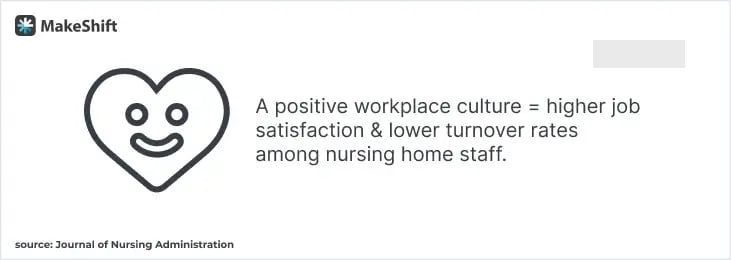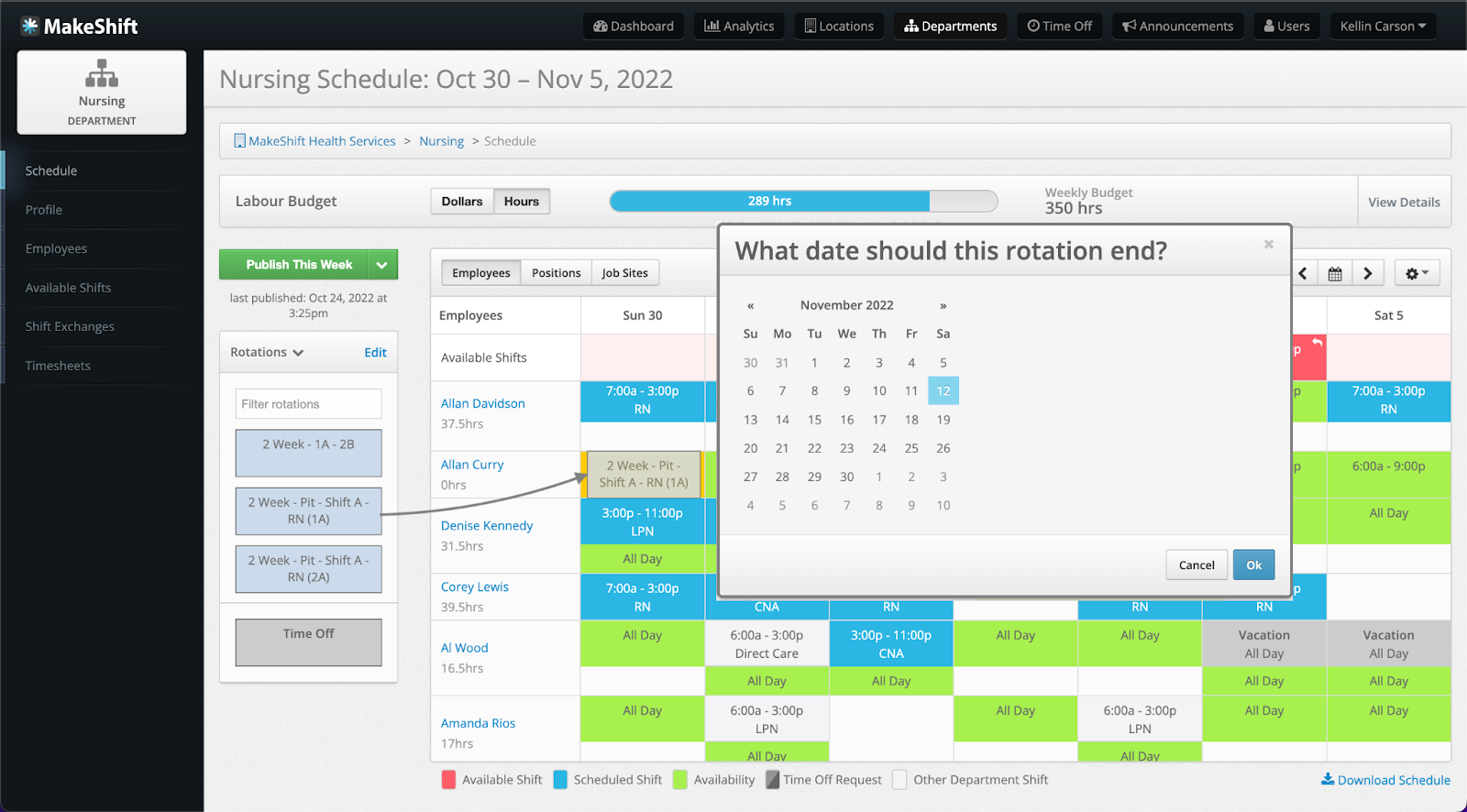It's no secret nursing homes are facing a staffing shortage — we’re in the thick of a staffing crisis.
With a growing aging population, the demand for long-term care services is increasing, and nursing homes are struggling to keep up.
Staff shortages can lead to subpar quality of care, lower patient satisfaction, and burnout among employees.
But it’s not all doom and gloom — you’ve got options to turn things around in your facility.
In this article, we'll explore 3 ways to address nursing home staffing issues. By adopting these strategies, you can improve the quality of care for your residents and support your workforce.
- Today’s Nursing Home Staff Shortage Crisis
- Why We Need to Address Nursing Home Staff Shortages
- What Is Causing The Nursing Home Staff Shortage?
- 3 Ways to Address the Nursing Home Staff Shortage
- MakeShift Can Help Manage Nursing Home Staff Shortages
Today’s Nursing Home Staff Shortage Crisis
Today's nursing home staff shortage crisis is a top concern for the healthcare industry, particularly due to the impact of the COVID-19 pandemic.
According to the American Health Care Association (AHCA), as of August 2021, there were over 80,000 vacancies for registered nurses and certified nursing assistants in nursing homes across the United States.

The average nursing home facility has a staff vacancy rate of 27%.
This shortage of staff has resulted in increased workloads and stress levels for current staff, leading to decreased quality of care and safety concerns for residents.
Why We Need to Address Nursing Home Staff Shortages
It’s essential to address today's staff shortage in nursing homes because it directly impacts your staff’s well-being and your residents’ quality of care.
You can’t ignore the staff shortage because the aging population is growing rapidly — more people than ever will need some type of long-term care.

- The global population of people aged 60 and older has more than doubled since 1980 and is projected to reach 2.1 billion by 2050.
- By 2030, the number of 60+ aged people will surpass the number of young people aged 15 to 24 for the first time in history.
- This aging trend is dramatically higher in developed countries, where the proportion of people aged 60 and over is projected to hit almost 40% by 2050.
Without enough staff, nurses and other healthcare workers are stretched thin, leading to burnout, fatigue, and subpar patient care.
This can lead to negative health outcomes for residents, including falls, infections, and medication errors.
Not only do these outcomes impact the residents, but they weigh heavily on the hearts and minds of residents’ families. Nursing homes are supposed to ease the burden of caring for your aging mom, not add worry, stress, and concern to an already tough situation.
Additionally, a staff shortage can also lead to increased stress and workload for the remaining staff, further exacerbating the problem. They work long hours to pick up the slack, which means they’re not home with their families as much as they need to be.
And burned-out staff means even when they’re home, they’re plagued by mental and physical fatigue. It’s tough to be present with your kids when you’re struggling to recover from work overload.
What Is Causing The Nursing Home Staff Shortage?
If you’re reading this article, you’re probably experiencing 1st hand the nursing home staffing issues.
Before we address what to do about it, let’s hit the high points of why the staffing crisis has occurred.
1. Shortages have gotten worse since the height of the pandemic
In 2022, nursing homes across the country reported their worst staff shortages since the federal government began tracking in 2020. 40% of facilities reported a shortage of direct care workers.
Employee priorities shifted after the pandemic.
They’re no longer willing to sacrifice work-life balance. If schedules are chaotic and the workload is a burden, many workers choose to leave their job or even change careers.
2. Post-acute challenges are unique and took a bigger hit
While staffing shortages in nursing homes reflect broader pandemic trends, they’ve been more severe than in acute facilities. Acute facilities experienced less of a drop in 2020 and have since had a more significant recovery.
The nursing home industry, on the other hand, has lost about 235,000 workers since March 2020. That’s about 15% of the nursing home workforce, and it significantly outpaced other healthcare sectors.
3. Hiring is a challenge
Today, almost every nursing home and assisted living provider says hiring new staff is a challenge.
Nurses are leaving for new kinds of work.
Nursing professionals are leaving work in post-acute care and finding employment in other areas — areas like hospitals, private homes, nursing agencies, and travel nursing positions.
Others took early retirement or returned to their home countries.
3 Ways to Address the Nursing Home Staff Shortage
Yes, we’re in a staffing shortage crisis in the long-term care industry. But we’d like to empower you to take action.
There are things you can do to support your existing staff and entice new healthcare workers to your facility.
1. Improve the work environment
We already mentioned that much of the workforce changed their priorities after Covid. They want to enjoy their work, feel like a valued team member, and work-life balance is not optional.
Focus on leveling up their work environment to support your staff and boost engagement.
- Raise wages and benefits — Nursing home RNs often become frustrated knowing they get paid less than nurses from agencies that do the same job. Increasing wages and benefits can help attract and retain qualified staff members and reduce staff turnover rates. This directly impacts the quality of care provided to residents.
- Provide training and educational opportunities — Now we know there’s only so much money you can throw at a problem. Another route to better your work environment is investing in ongoing education and training.
- Help staff members develop new skills and stay up-to-date with the latest industry best practices.
- Offering career advancement opportunities and professional development creates a sense of job security.
- This lets staff members know you’re in their corner and support them in growing their skills.
- Implement technology to streamline work processes — Scheduling software, electronic health records, and telemedicine tools, for example, can help streamline work processes and ease your staff’s workload.
2. Enhance recruitment and retention strategies
Sweeten the pot when it comes to recruiting new staff and retaining your current staff. Here are 3 ideas to kick off your brainstorming.
- Provide sign-on bonuses and other incentives — Sign-on bonuses and other incentives attract new staff members. Tuition reimbursement can also be a good incentive. Consider offering a yearly bonus to staff to reward staff members who stick around.
- Offer flexible schedules and work arrangements — Flexible work schedules can be particularly attractive to healthcare workers with family or other personal obligations. For example, offering a variety of shift options like part-time, full-time, weekend, and evening shifts can help to accommodate the scheduling needs of a diverse workforce.
- Create a positive workplace culture — This can include fostering a culture of respect, recognition, and open communication. Provide opportunities for professional growth and promote work-life balance.
A study published in the Journal of Nursing Administration found that a positive workplace culture was associated with higher job satisfaction and lower turnover rates among nursing home staff.

3. Optimize your workforce with tech
Use technology to ease your staff’s workload. The right tech can support your staff through automation, increased flexibility, and enhanced workforce optimization.
Focus on solutions specifically designed to support your staff and assist in managing patient care in long-term care facilities.
These software solutions can help streamline and automate tasks:
- Administrative tasks
- Manage patient medical records
- Track medications & treatments
- Facilitate communication among healthcare providers & residents’ families
- Care planning tools
- Intuitive staff scheduling
How MakeShift Can Help Manage Nursing Home Staff Shortages
Scheduling software can be a powerful tool in managing your nursing home staff shortage crisis.
MakeShift scheduling software was designed to help you create and manage staff schedules quickly and easily while making the scheduling process smarter and more interactive for both staff and managers.
Our favorite 5 nursing home-specific benefits are:
1. View and manage schedules on the go
Your staff can access their schedules, set availability, and submit requests right on their phone.
You can manage scheduling and approve requests while on the go. Mobile accessibility makes scheduling more interactive and lifestyle friendly.

2. Rotation-based scheduling
Easily create a rotating shift schedule to distribute the workload evenly. This helps alleviate staff burnout and fatigue and ensures that on-the-clock staff are mentally fresh. Renewed and recovered staff can offer more empathy when caring for your residents.

3. Compliance
There’s a lot going on in long-term care facilities, and it can be tough to stay compliant through manual monitoring. Ensure compliance with labor laws and regulations with overtime rules and automatic fatigue alerts.
MakeShift is a HIPAA-compliant software.

4. Improve staff communication
MakeShift provides a centralized platform for staff communication, which can help reduce scheduling conflicts and improve staff engagement.
With features like shift swapping and availability tracking, MakeShift empowers your nursing home staff to work together to fill staffing gaps and ensure everyone's needs are met.

5. Streamline scheduling processes
MakeShift Scheduling automates many of the time-consuming tasks associated with scheduling, such as shift creation, employee availability, time-off requests, and schedule distribution.
This saves time and reduces the administrative burden of scheduling.

MakeShift can be a valuable tool for your nursing home staff by improving staffing efficiency, reducing scheduling conflicts, and improving staff communication and engagement.
Combat Nursing Home Staffing Shortages Today
Staffing shortages in the long-term care industry are a problem for most nursing homes today.
While we acknowledge the staffing crisis — there are ways to combat the problem.
By leveling up how you support your staff, you can increase retention, attract new hires, and ensure high-quality resident care.
Ready to streamline your scheduling as the first step? Sign up for a free demo today.








.jpeg)